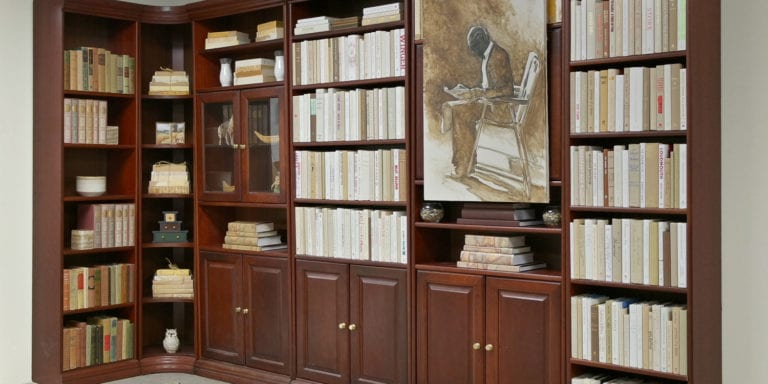
One must often suffer slings and arrows to gain acceptance when breaking new ground.
When did we first sell books for decorative purposes? Likely in the first weeks after I opened in September 1980. I vividly recall an early buy—my first? I really had little idea of what I was doing. It was in Buckeystown, Maryland. My first mentor and silent partner, Carl Sickles of Book Alcove in Gaithersburg, had given me a house call request he had received. (Carl was a Dickensian, small merchant/bookseller, and I will record some stories of that fine man in the future.) I had taken a “summer job” in his quirky, organic bookstore after belatedly finishing my college degree due to the deaths of both parents. I planned to attend grad school in English that Fall…well, this story is about Books by the Foot, so more on this will have to wait…but the short of it is—I was Book Alcove of Frederick from 1980-1983 when I amicably bought Carl’s share and changed the name to “Book Oasis.” The name lasted a week or two. Fortunately, “Oasis” never made it to the sign maker or printer for bookmarks or letterhead. “Wonder” seemed much more apropos for my plans and dreams.
…That first house call. It was an old, brick, manor house set well back from the road with a pedigree cattle farm surrounding it. The brick was painted white; the sills and sashes and trim black. A beautiful and wealthy venue. It had a towering high peaked slate roof. The woman who opened the door was old. She was likely 40! But she was as graceful and lovely as her antique filled home. She led me to the parlor. Upon a carved cherry coffee table were two stacks of old books bound in full leather. There were about twenty altogether.
“These are the books I’d like to sell.”
I dropped to my knees before them—the book surveying and buying position I’ve assumed thousands of times since. They were lovely creatures, tooled and gilded, pebbled and polished, calf and Morocco. Were they valuable? I had no idea and admitted so.
“My husband and I bought them in Paris. I just don’t want them anymore.”
I’ve always wondered what the backstory was. Speculation was easy. She certainly didn’t need the money or the space. I offered $100. That was quite a bit of money then—especially in those early straits. My weekly draw was $150 at the time.
She agreed and I wrote the check, on my knees, careful not to mar the wood beneath with the ballpoint pen.
Back at the fledgling shop, I placed the books in prime space on the shelf behind the counter at $10 each. All but one sold the next day to another “mature” woman whom I later found out was a local interior decorator. Why do I think that very early book sale in my career was for decorative purposes? Well, in all the years since, I’ve never had any luck selling Felicia Hemans’s poetry for any other purpose other than it’s binding. Nor, for that matter, most of the Tennyson, Moliere, Flaubert, Corneille…
I write this to exhibit that people have been buying books for their “looks” almost as long as there have been books.
The “but one”—the book I bought for myself? I kept a lovely, 1839 Percy Bysshe Shelley which I have to this day. For some reason, I’ve kept it in the tissue wrapping the former owner had kept it in. Odd, it hasn’t changed a bit in 37 years…
A couple years after that very early book sale, Carl called me and told me he’d give me a dollar for every Reader’s Digest Condensed Book I could get. There was a large, model home outfitter, and their designer liked the way they looked. I’d always passed on the many boxes of these books I’d been offered in the past. They were “unsellable.”
Unsellable…selling the unsellable…what a concept!
The Reader’s Digest Condensed Books made me a lot of money over the years. I’d buy them by the box. Carl would pay me well and take all I could get. I began soliciting them from scouts and flea marketers I knew. But, eventually, the model home designers moved on to a different look. But we STILL sell every Reader’s Digest Condensed Book we get in to a guy who repurposes them by the thousands.
…But in the mid 80s decorators and consumers began coming to the store and would say… “I need twenty-two and a half feet of books. I don’t care what they are as long as they look nice.”
They just wanted nice looking, hardcover shelf fillers. I only had to go as far as my fiction shelves to fill the order. I pulled off duplicates of Danielle Steele, James Michener, Tom Clancy…former bestsellers always seemed to self-propagate on the shelves overnight.
It was a great solution to a dilemma that bothered me deeply. I had a bad visceral response to every book we would HAVE to dispose of. Unlike Borges’s Universal Library, our shelves were not infinite. Now I could SELL my culls?! These were perfectly good, attractive books that when I needed more space we would have to make very tough, final decisions. There were no programs for recycling book paper then. Charities would refuse the common stuff. They tried to get me to take theirs! These books had no place to go and we had no place to keep them.
I began getting regular visits from North Carolina, “furniture” designers. They’d come every six months or so and pull all the nice leather books off my shelves. ALL of it—and they’d rarely dicker on pricing.
“Got any inexpensive vellum?”
Ummm…”rarely.”
The slings and arrows? Flash forward to the early 2000s. Wonder Book had grown and was growing. Other used bookstores were dropping like flies or retreating to their home basements or garages. There were huge book purges as no one was buying for retail stock. We were selling a lot of books online. But while we were buying everything in sight to feed the Internet beast, we started getting huge backlogs of common but still attractive books.
We were getting frequent calls from fellow booksellers asking, sometimes pleading, for us to just come buy the remaining stock after they’d had their Going Out of Business sales. Some just asked us to come take them.
Wonder Book wasn’t putting them out of business. Our stores were many miles from the DC and Baltimore Beltways. The Internet and big-box stores and people’s fascination with new, electronic, media gadgets were taking their toll. So many of the brick-and-mortar booksellers who were listed in the 1990s DC Metropolitan region printed guides and phonebooks were gone by 2010. Was it 90%?
As we bought more and more volume, we had more and more books that, although they looked just fine, were not viable online or in the three stores we now had.
I began looking for a solution better than recycling. Pulpers started accepting books in the 2000s. They’d pay us by the ton for scrap paper. There was no other choice for some books. Missing pages, obsolete, damaged…but I still had that painful feeling if a decent book had to go there.
What could we do?
Wonder Book was selling thousands and thousands of books one at a time online.
Hmmmm… If we could sell single books all over the world via the Internet, why not books for Interior Designers?
BooksBytheFoot.com was born.
Now, how to get people outside the region to discover us? We used the usual, guerrilla advertising tactics and experimented with paid ones too. We played with all kinds of permutations on AdWord sites. I had subscribed for decades to The New Yorker magazine. I loved the cartoons and the little ads (and I read the text in it too!) I put in a little ad for Books by the Foot.
Slings and arrows!
We started getting flamed in emails and letters!
“Outrageous!” “How crass!” “How tacky” “Book wh***” “Sacrilege!” … “Book killer!”
I got snarky emails like, “Dear Mr Foot, I have an apartment with built in bookcases. Can you fill them? I want only books whose titles begin with Z.”
Or this clever tongue-in-cheek email:
Dear Books by the Foot,
Recently browsing The New Yorker, I spotted your ad describing your service that provides “[d]ozens of styles for interior designers and book lovers, starting at $6.99 per linear foot.” How fortuitous my sighting was, and what an excellent business idea you’ve hatched!
It just so happens that I am a very well read individual, and it’s very important for me to appear this way, given my social stature and career aims. I currently live in Manhattan in an Upper West Side Apartment on West 84th Street—also known as Edgar Allen Poe Street after the poet who wrote his famous work “The Raven” while residing on this street.
I also happen to be in the throes of redesigning my home. In an effort to reflect my street’s historical significance, I have chosen to decorate my rooms in a manner that mimics Edgar Allen Poe’s short story, “The Masque of the Red Death.” In that tale Poe describes seven rooms each decorated in a different color: blue, purple, green, orange, white, violet, and black.
I too have seven rooms. I would like them to be decorated in the colors listed above. Therefore I am most interested in your “Books by Color” service, which I plan to use, but only if you can meet one condition: I need to have my book order calculated in metric meters rather than linear feet. This is crucial to whether I choose to use your services in my elaborate decorating project. I am unable at this juncture to entirely explain my reasons but suffice to say I am currently under the sway of Continental influences.
Please let me know if a book by the meter order will be possible at your earliest convenience. Also do you possibly have some adult-sized t-shirts with your company’s logo appearing on them so that I could wear them about town, specifically to my Pilates lesson?
“Convinced myself, I seek not to convince” (Poe),
My good-humored reply:
Dear […],
This is great!
Sure, we can do this.
We’ve supplied books as props to horror movies (think “musty old castle like A CASK OF AMONTILLADO). We have books in Broadway shows in Manhattan right now.
We are traditional booksellers and www.BooksBytheFoot.com serves as an outlet to place books which have no “reading value.” In most cases these books would otherwise be pulped.
So, please let me know your budget and we will begin the process.
Please be sure you need the measurement in “metric meters.” I wouldn’t want to ruin your design by sending the wrong kind of meters.
If you need to do anymore research on Poe please see our main site: www.wonderbook.com.
We are proud to have “recycled” millions of books sine 1980—mostly one at a time to booklovers.
Other emails were not so subtle. Some went on for line after line after line, single-spaced, no paragraphs, telling me how I was part of the decline of western civilization…and worse.
Fun and games.
With three brick-and-mortar, used bookstores and a growing online presence, we were getting a “big, corporate monolith” reputation with some folks in and out of the trade. It confused me. I was just the same book guy I’d been when I wasn’t able to cash my $150 per week paychecks.
I still spent much of seven days a week rooting through boxes and carts of books. I was a book guy. I didn’t feel like a President or CEO.
Insult and gossip was heard and felt online and in chat rooms. I belonged to some trade associations; some whose members were embarrassed to have Wonder Book listed in their ranks.
Begin the PR campaign and explanations.
How could we convince those with firmly concreted, preconceived notion that we were ripping books out of the hands of readers and collectors to fulfill some designer’s vision of matching the books’ spine colors with the carpet and drapes? I don’t know how many times I wrote, “These are books that would otherwise be pulped. If we could sell them to readers or collectors, we’d do that.”
“Why don’t you donate these books to people who would read and love them?”
“They don’t want these books. These are books that charities sell to us!”
To some particularly rabid critics, I made the offer, “I’ll let you come pick all you want from these at 25¢ each. How many thousands can you use?”
Then in 2008, a Washington Post reporter came out and gave us a positive treatment.
C-Span came soon after: Recycled Book Business.
In 2011, Penelope Green wrote a feature in The New York Times: Selling a Book By Its Cover.
After explaining what we were doing and why from every angle I could think of, some of my stodgier colleagues began to “get it.”
We were SAVING these books from the “farm” (i.e. the pulp mill.)
Soon some of them began selling me their cast-offs. Beautiful antique leather and cloth began to appear. Boxes and van loads of old, unsellable books turned into dollars for them, supplied a hungry market for the “vintage” look of old cloth and leather, and became a good sideline for our main business of selling books to readers and collectors.
“Give us your tattered, battered, bruised, and torn; give us your odd volumes and broken sets…yearning to be shelved once again.”
There was an iconic bookstore in Boston from the 1800s until the 1990s. Goodspeed’s. I’d come across old catalogues from the first half of the 20th century. Many had a motto imprinted on the cover:
Dumbarton Oaks Library states:
Goodspeed’s Book Shop opened in 1898 at Beacon and Somerset streets in Boston, Massachusetts. Opened by Charles Eliot Goodspeed, the shop quickly became well known for its carefully curated selection of books, prints, autographs, and maps. The logo on their sign, which featured a monk reading a breviary and the words “Anything that’s a book,” became an icon.
(link, vintage picture of Goodspeed’s)
That had been my guiding philosophy since the beginning. I’d always, from the first day, tried to find a new home for every book that came in, whether it be a paperback romance, comic book, or rare collectible.
It has been a challenge and a puzzle and a passion here since the enterprise’s inception to find a new home…one more use…for every book that comes in. Whether we ship them overseas in containers for pennies a book or place them in a rare book collector’s hands for hundreds of dollars apiece or anything in between—we consider it a victory—for us and the “book.” Books by the Foot is just another way we’ve found to expand that mission. Every gorgeous book that finds a new home via Books by the Foot is another win for the “book.” Especially for books for which there is no other option.
Last year, Bob Garfield of Public Radio fame came and took a tour of our 3-acre warehouse crammed with books. He created a very funny, word picture on his show “On the Media” of what we do and why. Although he had to pause and crack up more than a few times when, for example, the surprise of walking into a room full of books arranged on shelves not by author or subject or by Dewey Decimal System but rather by spine color.
He “Got it.” Link to WNYC’s “The Business of Books by the Foot”
Now I hope most of you do too.
#BookRescue

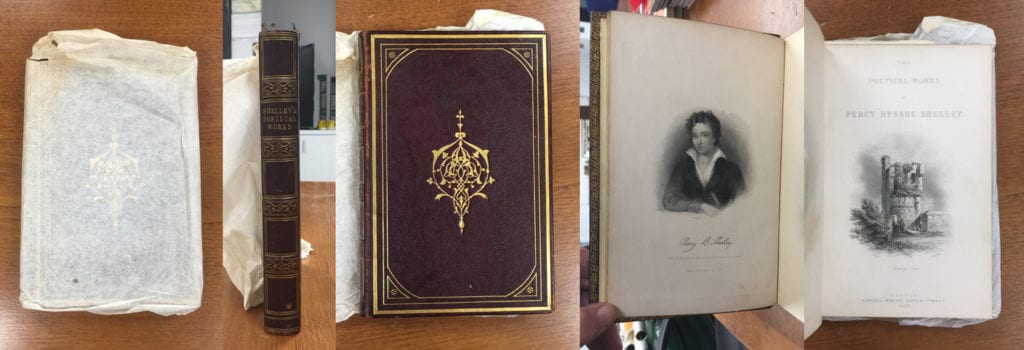
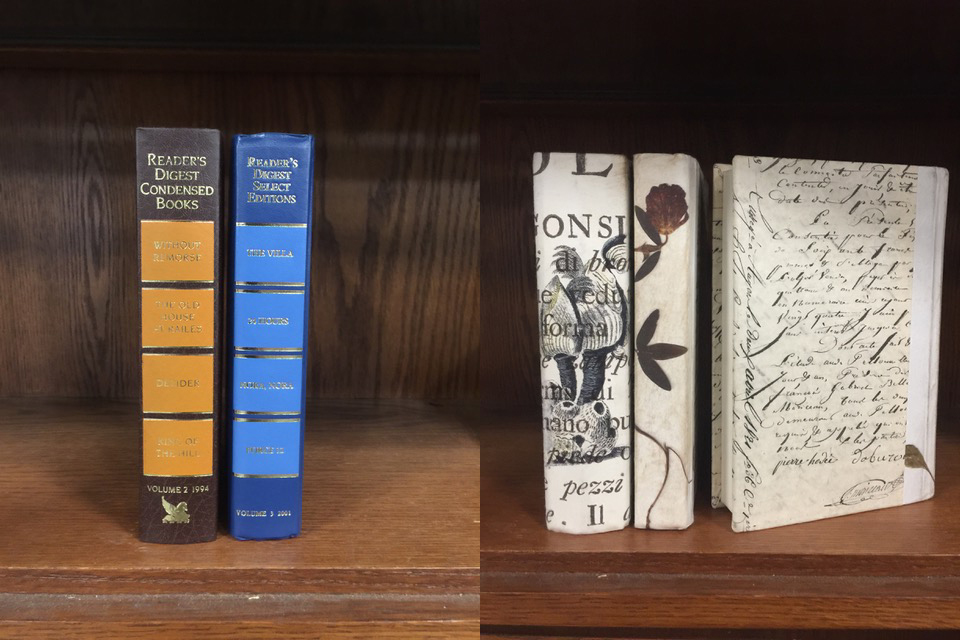
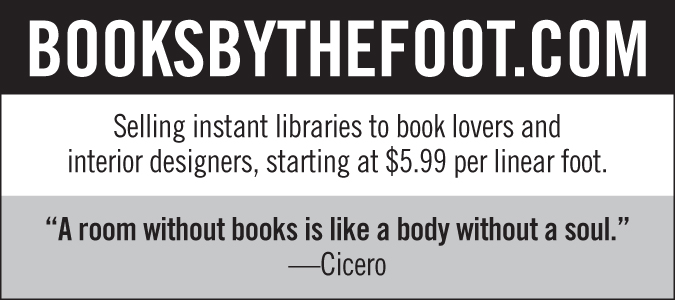

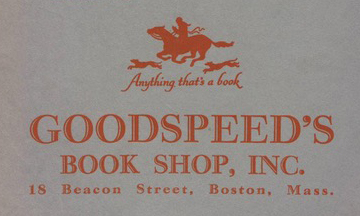
[…] Books that we have too many copies of or for which there is no audience we can often sell in our Books By the Foot division. We donate a lot of kid’s books. If there’s no way to keep a book a book—even for […]